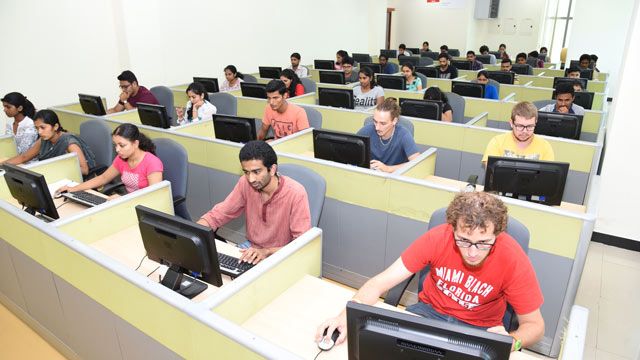Manipal Institute of Technology Integrates MATLAB and Simulink into the Engineering Curriculum
“We are fortunate to have the autonomy to define a curriculum that enables us to best prepare our students and differentiate our university from other schools. To help us meet those goals, we have integrated MATLAB and Simulink into the engineering curriculum, starting in the first year.”
Challenge
Revise the core curriculum in the college of engineering to build upon a reputation for producing industry-ready graduates and improve worldwide rankings
Solution
Provide students and faculty with campus-wide access to MATLAB and Simulink and integrate the tools into introductory and upper-level engineering courses
Results
- Students well-prepared for graduate studies
- Learning environment improved with expanded access to tools
- Competitive edge ensured

Manipal Institute of Technology students in the lab.
Consistently ranked as the best private university in India, Manipal Academy of Higher Education (MAHE) was recognized in 2018 as an Institution of Eminence by Ministry of Human Resource Development, Government of India. Institutions so recognized are provided with incentives to improve their world rankings by adopting new teaching standards and promoting research.
Manipal Institute of Technology (MIT), the College of Engineering at MAHE, recently revised the curriculum to ensure that graduates from its 16 undergraduate programs and 25 postgraduate programs are well-prepared for careers in industry or for further graduate studies. One key change was the introduction of MATLAB® and Simulink® early in the curriculum.
“In the past, India relied heavily on the IT sector for employment, but the situation is changing, with core engineering playing a larger role,” says Dr. Vinod V. Thomas, Registrar - Evaluation at MAHE, and Professor, Department of Electrical Engineering, MIT. “Teaching engineering design skills with MATLAB and Simulink helps us ensure that our graduates are industry-ready.”
Challenge
Manipal Institute of Technology wanted to build on its reputation for producing graduates ready to meet the demands of industry or academic research. The school already had a higher placement rate for core engineering graduates than most other engineering institutes in India. The faculty wanted to raise that rate still higher by revising the curriculum to better integrate hands-on learning with classroom teaching.
Faculty in the Electrical Engineering programs had been using MATLAB in their courses for several years. Dr. Thomas and his colleagues wanted to extend the benefits of learning MATLAB and Simulink early to students across all engineering programs. To achieve that goal, they needed to expand the students’ access to the tools, which at the time was limited to labs on campus.
Solution
Manipal Institute of Technology integrated MATLAB and Simulink into the engineering curriculum, acquiring a Campus-Wide License that lets faculty and students access the latest release of the products anytime and from anywhere.
One of the earliest curriculum changes that the college implemented involved the first-year course CSE 1001: Problem Solving Using Computers. A core requirement for all Bachelor of Technology students, the course now introduces about 2000 students each year to the principles of programming in both MATLAB and C.
In addition to learning basic control structures, data structures, operators, functions, and file handling, students tackle more advanced topics, such as parallel programming on GPUs, object-oriented programming, and modeling and simulation with Simulink.
The students build on the skills they develop in this introductory course in upper-level courses covering signal and image processing, control systems, neural networks, and fuzzy logic. An open elective, ELE 3287: MATLAB for Engineers, extends the concepts introduced in CSE 1001 with code generation and simulation of mechanical and electrical systems in Simulink.
With the campus-wide license, students are no longer restricted to designated lab slots but can complete MATLAB and Simulink assignments on their own laptops wherever and whenever they choose.
Outside the classroom, MIT teams have used MATLAB and Simulink to design and build systems for several international student competitions, including Formula Student, University Rover Challenge, and SAE Aero Design.
At least once each semester, MathWorks engineers visit the campus and conduct training sessions for both students and faculty. “Working with MathWorks engineers provides the students with motivation and gives faculty the chance to see new features and tools that they can use in their classrooms,” says Dr. Thomas.
Manipal Institute of Technology faculty use MATLAB and Simulink extensively in their own research projects, several of which have led to published papers, and many undergraduate and graduate students now complete their capstone projects using MATLAB and Simulink.
MATLAB and Simulink have been integrated into the curriculum most extensively by the electrical engineering faculty, followed by the chemical engineering faculty. The college is working on extending integration to the automotive, civil, mechanical, mechatronics, and other engineering programs.
Results
- Students well-prepared for postgraduate studies “A sizable number of our undergraduates pursue master’s degrees abroad,” says Dr. Thomas. “Many of these students have written to thank us for introducing them to MATLAB and Simulink because the experience has given them an edge in their graduate studies.”
- Learning environment improved with expanded access to tools. “The campus-wide license made it possible for us to introduce MATLAB and Simulink to a first-year class of 2000 students,” notes Dr. Thomas. “Faculty and students can now use the tools around the clock, inside and outside the classroom, which has been critical to improving our learning environment and the preparedness of our students.”
- Competitive edge ensured. “Our students have an advantage over their counterparts at other schools because they learn how to solve engineering problems using industry-standard tools like MATLAB and Simulink,” says Dr. Thomas. “Giving our students this advantage differentiates us from other universities and helped us achieve our university-wide goal as an Institute of Eminence.”
Acknowledgements
Manipal Institute of Technology is among the nearly 1000 universities worldwide that provide campus-wide access to MATLAB and Simulink. With the Campus-Wide License, researchers, faculty, and students have access to a common configuration of products, at the latest release level, for use anywhere—in the classroom, at home, in the lab or in the field.